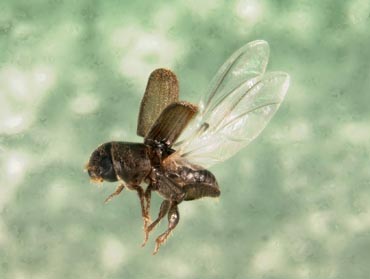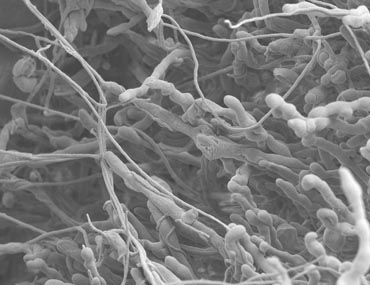Wielding microbe against microbe, beetle defends its food source
As the southern pine beetle moves through the forest boring tunnels inside the bark of trees, it brings with it both a helper and a competitor. The helper is a fungus that the insect plants inside the tunnels as food for its young. But also riding along is a tiny, hitchhiking mite, which likewise carries a fungus for feeding its own larvae.

A pernicious forest pest of the southern United States, the southern pine beetle is also known for its curious symbiotic relationships with microorganisms. Not only does it associate with a fungus that serves as food for its larvae, but researchers have now found that it harnesses an antibiotic-producing bacterium to protect its fungus from a competing one. The team, led by Cameron Currie, a UW–Madison bacteriology professor, and Jon Clardy, a Harvard University chemist, reported its results in the Oct. 3, 2008 issue of Science.
Photo: Erich Vallery, USDA Forest Service
Now the picture of this peculiar, millennia-old arrangement has grown even more curious. Writing in the Oct. 3 issue of Science, a team of researchers reports that the pine beetle harnesses a second microorganism — a bacterium known as an actinomycete — to protect its fungus from the mite’s competing one. What’s more, the bacterium does so by wielding an antibiotic that is brand new to science.
The isolation of the novel antifungal compound — dubbed mycangimycin for the specialized compartments, or mycangia, in which the beetles carry both their fungi and bacteria — raises the intriguing possibility that other such discoveries could follow.
“There are perhaps 10 million species of insects on the planet,” says UW–Madison evolutionary biologist and symbiosis expert Cameron Currie, who led the study with Harvard University chemist Jon Clardy. “So if insects associate with actinomycetes like this more generally, then there’s potentially a huge number of new places to explore.”
The realization couldn’t come at a better time. Historically, the greatest source of antibiotics in the world has been the actinomycetes, especially members of the genus Streptomyces. But in recent years, the number of new compounds successfully isolated from these organisms — and indeed from all microbes — has dwindled, even as resistance to existing antibiotics has spread.

In this image, taken with scanning electron microscopy, two microbial associates of the southern pine beetle blanket the surface of a tiny tunnel carved by the insect in the inner bark of a tree. The knobby structures are filaments of a fungus that the beetle uses as food for its larvae, while the longer, string-like filaments are a bacterium that protects the fungus from a competing one.
Image: M. Cetin Yuceer, Mississippi State University
Whether symbiotic associations end up being a treasure trove of new antimicrobials and other useful agents remains to be seen. But it’s promising to see insects pairing up with actinomycetes.
“Actinomycetes are likely very attractive in these situations because of their potent antibiotic-producing abilities,” says UW–Madison graduate student, Jarrod Scott, who works with Currie. “In much the same way that we recognize the power of these microorganisms, I think other organisms, in an evolutionary sense, have also recognized their power.”
Currie also has good reason to suspect these interactions are widespread. In the 1990s, he was the first to discover that a fungus-farming ant, the leaf-cutter, used an actinomycete to protect its fungal crop from a parasitic mold. That got him thinking about the importance of parasites and disease in the evolution of all organisms, and how these pressures may have led many insects to team up with beneficial microbes as a defense.
Beyond the leaf-cutting ants and pine beetles, one other example of this type of relationship is now established. “But it hasn’t been systematically examined,” says Currie. “If we actually start to look, we may find these associations to be very common.”
That one of the pine’s most devastating enemies in the southern United States and Mexico relies so heavily on a bacterium seems incredible, but that’s precisely the case for the southern pine beetle. If the beetle’s fungus, Entomocorticium, is outgrown by the mite’s fungal partner, Ophiostoma, the beetle larvae will starve. Holding Ophiostoma in check has therefore become the job of the actinomycete.
What’s interesting about the small molecule antibiotic it produces, though, is that it doesn’t seem to target Ophiostoma specifically. The researchers instead suspect Entomocorticium has developed some resistance over time, says Scott, allowing it to survive the same low doses of antibiotic that wipe out its competitor.
This suggests the antibiotic could have broad-spectrum activity against other fungi and parasites, a possibility the team is now investigating. And the discovery of a novel antifungal compound is especially exciting because many of these agents can serve double-duty as anticancer drugs, says Currie.
But for him and Scott, the greatest outcome would be wider recognition of the crucial role microbes play in the lives of all plants and animals, not just as parasites, but frequently as partners.
“Organisms like the pine beetle wouldn’t be able to do what they do without microbes,” says Scott. “So, we’re interested in microorganisms as the basis of their success.”
The study’s other authors are Dong-Chan Oh of Harvard, M. Cetin Yuceer of Mississippi State University and Kier Klepzig of the U.S. Forest Service. Currie’s work was funded by the USDA and the National Science Foundation.
Tags: biosciences, entomology, learning, research



